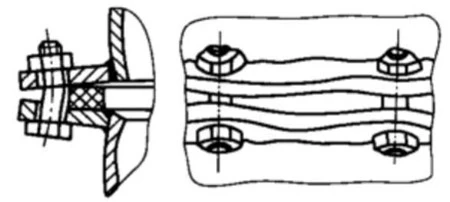The contact surface where the gasket is inserted between the flanges and pressed to achieve a sealing effect is called the flange sealing surface or the pressing surface. The selection of the sealing surface type is related to the operating conditions, the consequences of leakage and the nature of the gasket. The common structure types are as follows.
Flat sealing surfaces
The structure of the flat sealing surface is shown in the figure (a) below.
The sealing surface is not a smooth plane. There are often triangular cross-section grooves in the two to four concentric on the plane. The flat sealing surface has a simple structure and is convenient to manufacture,which is convenient for anti corrosion lining. The width of the sealing surface of this structure is large, so nonmetal or metal soft gaskets are often used. Although after the bolts are tightened, the gasket material is easy to stretch to both sides. The flat sealing surface is used in situations where the required pressing force is not great and the medium is non-toxic.
Concave and convex sealing surfaces
The structure of the concave and convex sealing surface is shown in the figure (b) below. It is equivalent to a pair of flat sealing surface flanges, and one of which is made as a pressing surface with a raised face and is called a convex flange. Another corresponding surface with a concave face is called a concave flange. The gasket which has the same size as the concave face is embedded, and the gasket is easy to center. The height of the convex surface is slightly greater than the depth of the concave surface, and it is tightly pressed with bolts to play a sealing role. This structure can limit the radial deformation of the gasket and prevent the gasket from being squeezed, which improves the sealing performance to a certain extent. It is suitable for occasions with high pressure.
Tongue and groove sealing surfaces
In the middle width direction of a pair of flat sealing surfaces, one surface is made into a cross-section like a tongue, and the other cross-section is like a groove pressing surface. See the picture (c). The first one is called a tongue flange, and the second groove flange.
The groove-shaped pressing surface can limit the radial deformation of the embedded gasket, which has good sealing performance, and the gasket can be less eroded and corroded by the medium. However, the tongue part is easy to be damaged. The groove-shaped pressing surface is often used in flammable, explosive, toxic media and high pressure occasions.
In addition, there are trapezoidal groove sealing surfaces and tapered sealing surfaces. The former uses an elliptical cross-section annular metal gasket, and the latter uses a lens-type annular metal gasket. The above two structures are forced seals, which are commonly used for high-pressure pipelines.
The form and surface properties of the flange sealing surface play a vital role in the influence of the sealing effect. The flatness of the flange sealing surface and the perpendicularity between the sealing surface and the flange center line directly affect the uniformity of the gasket force and the good contact between the gasket and the flange. The roughness of the sealing surface of the flange should meet requirements for the gasket. Radial knife marks or scratches on the surface are not allowed, let alone surface cracks.
The structure of the sealing surface

Flange rigidity
Excessive warpage caused by insufficient flange rigidity (as shown in the figure below) is often one of the main reasons for the failure of the bolt flange connection seal in actual production. A flange with large rigidity has small deformation, and the pre-tightening force of the bolt can be evenly transmitted to the gasket, improving the sealing performance of the flange.
The warpage of the flange

The rigidity of the flange is related to many factors. Appropriately increasing the thickness of the flange ring, reducing the diameter of the bolt center circle and increasing the outer diameter of the flange ring can increase the rigidity of the flange. Using a necked flange or increasing the size of the cone neck can significantly improve bending resistance of the flange. However, if the rigidity of the flange is increased without principle, the flange will become bulky and the cost will increase.
Operating conditions
The influence of pressure, temperature and the physical and chemical properties of the medium on the sealing performance is very complicated. The influence of pure pressure and medium on the sealing is not significant. However, under the combined action of temperature, especially under fluctuating high temperatures, they will seriously affect the sealing performance, and even make the sealing completely fail due to fatigue. At high temperatures, the viscosity of the medium is small; the permeability is great and it is easy to leak. The corrosive effect of the medium on gaskets and flanges is intensified, increasing the possibility of leakage. Flanges, bolts and gaskets will all produce great high temperature creep and stress relaxation, which makes the seal ineffective. Aging, deterioration and even burn will be accelerated for some nonmetallic gaskets.